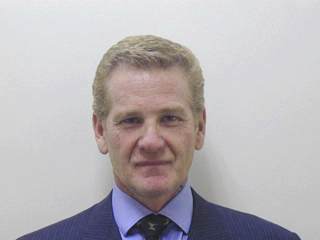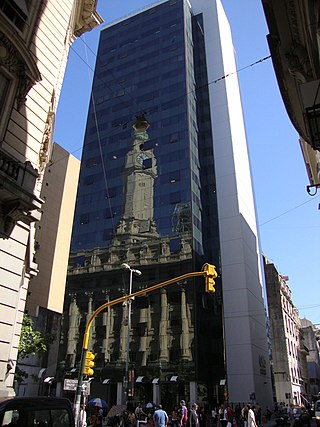Related Research Articles

Communications in Argentina gives an overview of the postal, telephone, Internet, radio, television, and newspaper services available in Argentina.

Canal 13 is an Argentine free-to-air television network and the flagship station of the network of the same name, located in the capital of Argentina, Buenos Aires. It is owned by Grupo Clarín through Artear.

Clarín is the largest newspaper in Argentina and the second most circulated in the Spanish-speaking world. It was founded by Roberto Noble in 1945, published by the Clarín Group.

Channel 9, known by its brand name El Nueve is an Argentine free-to-air television network based in Buenos Aires with programming centred on general entertainment.

Telecom Argentina S.A. is the major local telephone company for the northern part of Argentina, including the whole of the city of Buenos Aires. Briefly known as Sociedad Licenciataria Norte S.A., it quickly changed its name, and is usually known as simply "Telecom" within Argentina.

América TV is an Argentine television station broadcasting on channel 2 in La Plata, Buenos Aires Province, Argentina, and one of Argentina's five national television networks. It is owned by Grupo América.

Promotora de Informaciones, S.A. (PRISA) is a Spanish media conglomerate headquartered in Madrid, Spain. It is one of the largest media companies in Spain and all of Latin America, producing a wide variety of educational, cultural and informative content. PRISA owns a portfolio of newspapers, magazines, radio stations, and television networks. The majority subsidiaries and brands of the company are El País, Los 40, and Santillana.
David Martínez Guzmán is a Mexican investor who is the founder and managing partner of Fintech Advisory. This firm specializes in corporate and sovereign debt. Fintech Advisory has offices in London and New York City, and he currently divides his time between those two cities.
La Razón was a local newspaper distributed in the public transport in Buenos Aires, Argentina.

Francisco de Narváez Steuer, known as El Colorado or Pancho, is a Colombian-born naturalized Argentine businessman, politician who ran for governor of Buenos Aires Province on the Unión PRO ballot in the 2007 elections in Argentina. He was a member of the Argentine Chamber of Deputies until late 2015.

Ernestina Laura Herrera de Noble was a prominent Argentine publisher and executive. She was the largest shareholder of the Grupo Clarín media conglomerate and director of the flagship Clarín newspaper. She was the first woman to become director of a mainstream newspaper in South America.
Unidad Editorial, S.A. is a Spanish media company. It owns the newspapers El Mundo, Expansión and Marca. It is primarily owned by the Italian holding RCS MediaGroup.

Grupo Clarín S.A. is an Argentine media conglomerate headquartered in Buenos Aires.

Radio in Argentina is an important facet of the nation's media and culture. Radio, which was first broadcast in Argentina in 1920, has been widely enjoyed in Argentina since the 1930s. Radio broadcast stations totaled around 150 active AM stations, 1,150 FM stations, and 6 registered shortwave transmitters. An estimated 24 million receivers were in use in 2000.

The Argentine Governments of Néstor Kirchner and Cristina Fernández de Kirchner had several conflicts with major media groups. Kirchner accused the Clarín Group, La Nación, Perfil, and related media of having promoted their overthrow.

José Luis Manzano is an Argentine businessman and former politician. He is currently a partner in the second largest multimedia group in his country, Grupo América, and has investments in several economic sectors, including energy, wine, and clothing. During his time in Argentine politics, Manzano was known as a power broker and negotiator and one of the architects of the success of the Menem government.

A number of cacerolazos, pot-banging protests, took place in several cities of Argentina on September 13 and November 8, 2012. The first, in September 13, was a national protest against the policies of the president Cristina Fernández de Kirchner. The protests generated significant repercussions in local politics. The second, on November 8, was another much more massive protest in several cities in Argentina, including Buenos Aires, Córdoba, Rosario, Mendoza, Olivos, among many others throughout Greater Buenos Aires and other regions. There were also protests in Argentine embassies and consulates in cities such as New York, Miami, Madrid, Sydney, Bogotá, Santiago and Barcelona, among others. Its complaints were almost the same, but the difference in size was very big. The protests are considered not only a call to Kirchnerism, but also to the opposition, because they did not have a strong leader.
Daniel Eduardo Vila is an entrepreneur, former sports director and lawyer in Argentina. He is president of America TV and Radio La Red, besides being the owner of the media Grupo América, in partnership with the former politician José Luis Manzano. He is also owner of Journal One, a leading newspaper published in Mendoza, Santa Fe, Entre Rios and Rosario. He is also president of Diario La Capital de Rosario and president of Club Sportivo Independiente Rivadavia of Mendoza.

Grupo América, formerly known as Grupo UNO Medios, and also known as the Vila-Manzano Group, is a multimedia company in Argentina created by the Mendoza entrepreneurs Daniel Vila and the ex-politician and businessman José Luis Manzano. Is one of the owners of América TV, as well as many other TV channels, newspapers, radios and digital businesses throughout the country.

The National Communications Entity is the national communications and media regulator of Argentina. It was created by a presidential decree in 2016 and combines the former Federal Authority for Audiovisual Communication Services (AFSCA) and the Federal Authority for Information and Communication Technologies.
References
- 1 2 3 4 5 Becerra, Martín; Marino, Santiago; Mastrini, Guillermo (2012-02-29). "Mapping Digital Media: Argentina" (PDF). Open Society Foundation.
- 1 2 3 4 "Argentina". Digital News Report. Retrieved 2020-03-18.
- 1 2 "Media in Argentina: Newspapers, Internet, Radio & T.V." Retrieved 2020-03-18.
- 1 2 3 4 5 6 7 8 9 10 11 "Argentina's media: Big business for a few | Reporters without borders". RSF. 2019-04-10. Retrieved 2020-03-18.
- 1 2 "Argentina - History of the mass media". www.amautaspanish.com. Retrieved 2020-03-18.
- ↑ Seifert, Daniel (February 10, 2012). "Jugosa cosecha de Manzano". Noticias. Archived from the original on October 27, 2014. Retrieved 26 October 2014.
- ↑ "World Report 2019: Rights Trends in Argentina". Human Rights Watch. 2018-12-20. Retrieved 2020-03-18.